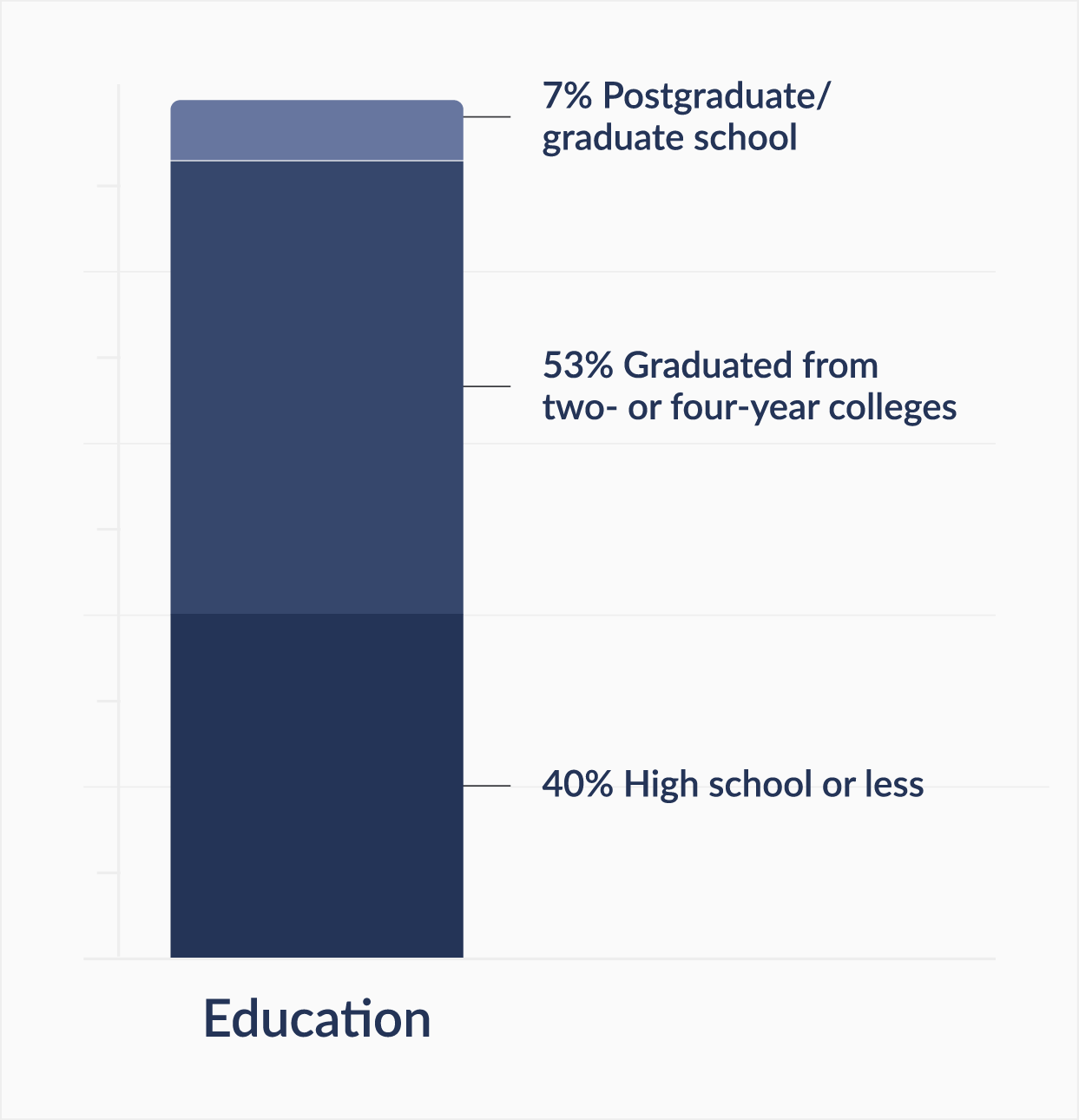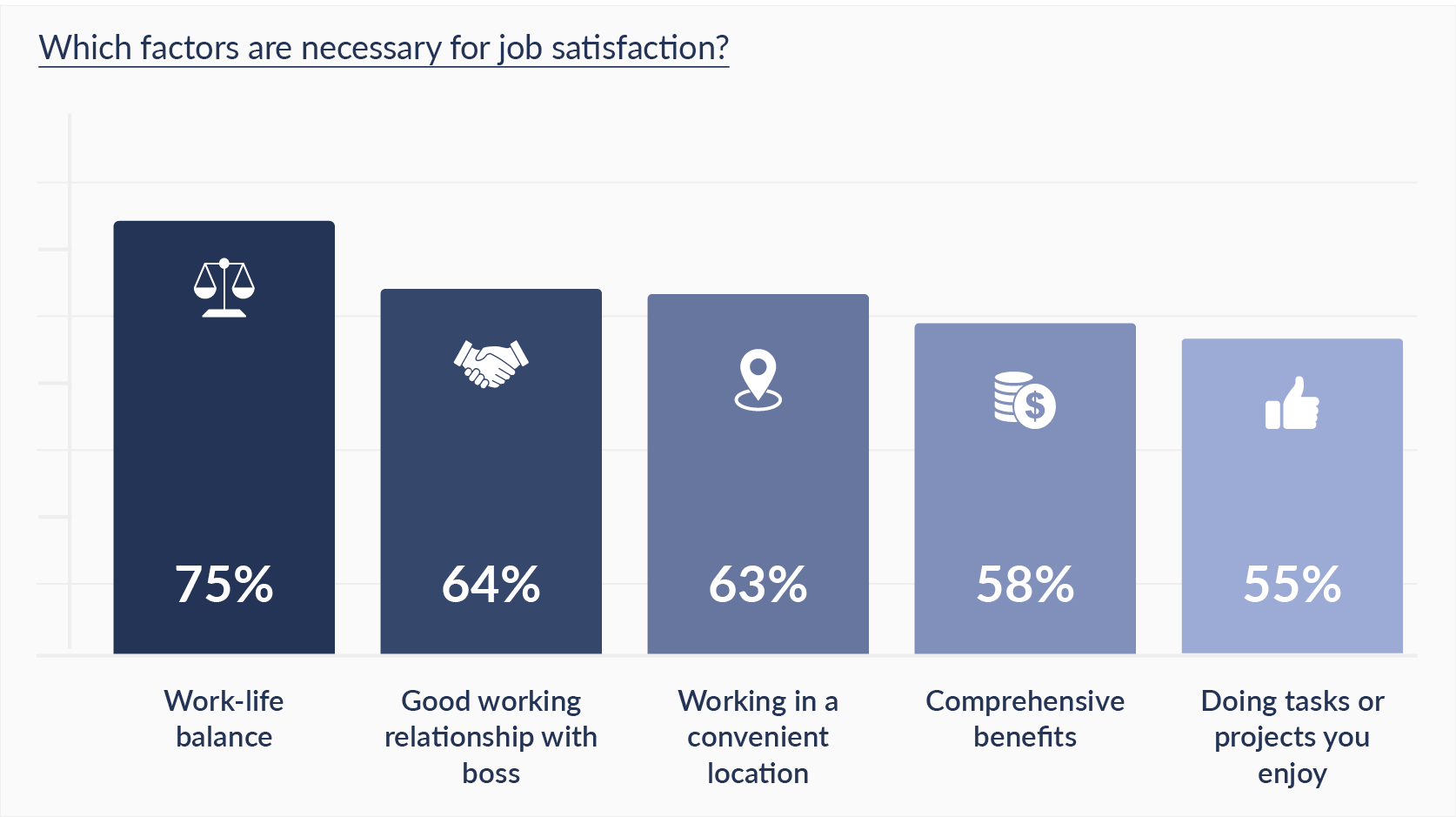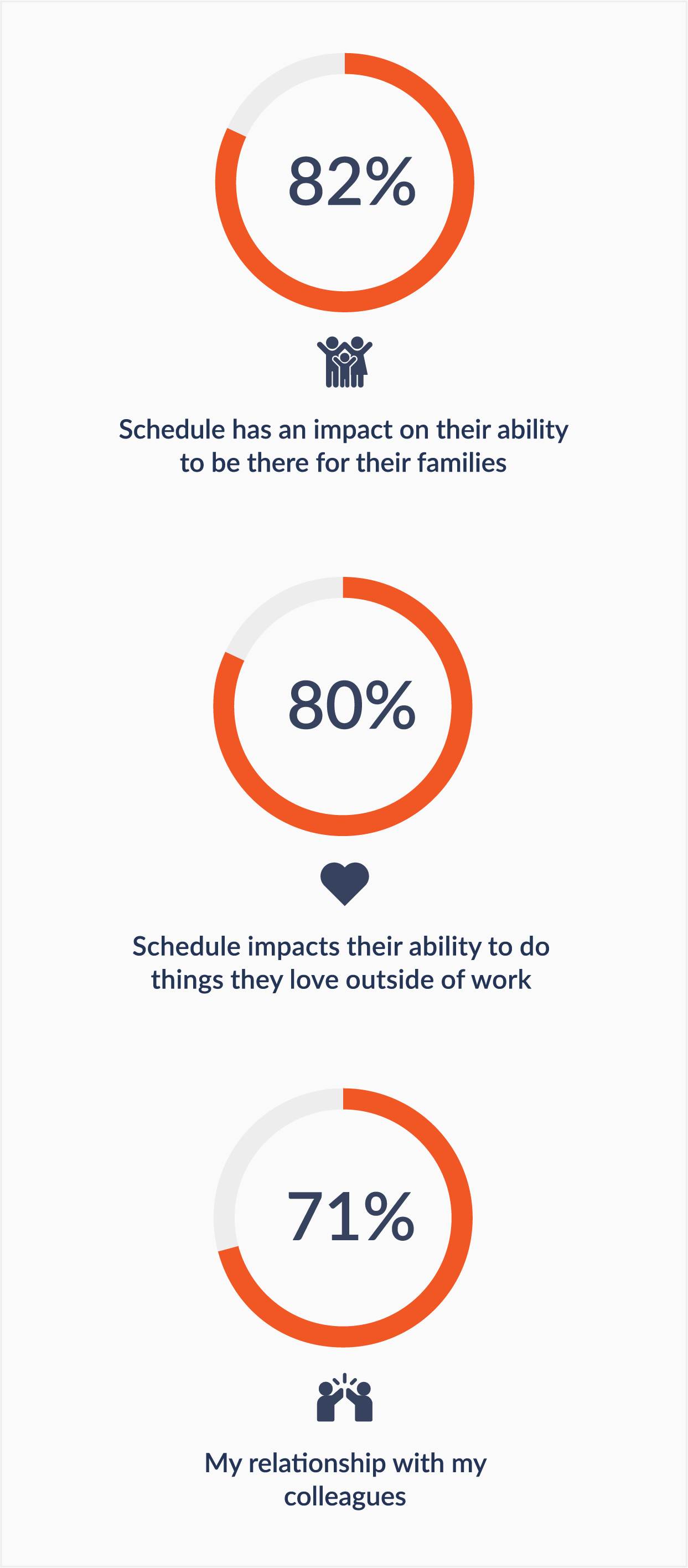Strategies For Hourly Employee Satisfaction
The world of work has undergone tremendous change over the last three years. A change that has had a profound impact on workers. The Covid‐19 pandemic, followed by the Great Resignation, and ongoing global conflicts are just a few forces affecting hundreds of millions of American workers’ livelihoods.
Organizations with hourly or shift‐based workers are facing unprecedented challenges, as well. Market conditions, such as the ongoing labor shortage, have impacted the finding and retaining of qualified shift workers. Yet, it’s clear that organizations that understand the needs of their workers and prioritize job satisfaction become employers of choice.
As a leading provider of workforce scheduling solutions, Shiftboard has been conducting surveys of American workers to understand their perspectives and needs since 2019. Indeed, our 2019 Hourly Worker Report confirmed a strong labor market with high turnover rates and rising employment expenses.
The results of our 2023 report reflect similar trends to those seen in 2019. The United States is still in a strong labor market. For organizations in industries dependent on hourly and shift workers, job opportunities remain abundant. This report dives deep into the mindset and motivations of the workers in the new era.
Understanding hourly employee preferences, how employees relate to their work schedules, and implementing strategies to address those needs can significantly impact job satisfaction and engagement. By prioritizing employee well‐being, workforce managers can create a more positive work environment and foster a culture of trust and respect. This approach will lead to better business outcomes, such as reduced labor costs, higher employee retention, improved customer satisfaction, and increased innovation.
Table of Contents:
Who Are Hourly Workers?
According to 2021 data from the U.S. Bureau of Labor, nearly 78.7 million hourly workers, 60% of the U.S. workforce, are employed in critical frontline industries.
Of these workers, respondents to our survey were split evenly between male and female (50% each).
The majority, 66% of respondents, were between the ages of 27 and 58. Specifically, 35% were Millenials born between 1981 and 1996, and 31% were Gen X born between 1965 and 1980. Another 20% were Gen Z born between 1997 and 2012, and 13% were Baby Boomers born between 1946 and 1964. Together, Gen Z and Baby Boomers account for 33% of respondents who were either just getting started in the workforce or heading toward retirement.
From a household perspective, 47% were married, 42% were single, and 11% were divorced or separated.
An awareness of these varied demographics is critical for workforce managers, as the past’s one‐size‐fits‐all management strategies and processes are no longer relevant for attracting and retaining talent in today’s complex labor landscape.
Hourly Worker Education and Income
Our study revealed that shift workers tend to have completed higher education and have significant earning power. Notably, 53% have graduated from two‐ or four‐year colleges. Another 7% of the hourly workforce has an advanced degree, while 39% report having a high school diploma or less.

Nearly half of the hourly workers in our survey claim household incomes between $50,000 and $99,999, with 15% reporting household incomes of $100,000 or more. Still, about 40% reported an annual income under $50,000, highlighting the presence of lower‐income workers in this sector. The data suggests that shift work can offer meaningful employment opportunities for individuals with varying levels of education and income.
How Do Work Schedules Impact Hourly Employee Satisfaction and Retention?
The Work Schedule Impacts Work‐Life Balance
As our 2019 research showed, many factors, from pay to location to enjoying the task at hand, contribute to an hourly worker’s positive view of their job. However, one of the most enduring insights was the importance hourly workers place on work‐life balance.
Three‐quarters (75%) of hourly workers polled ranked work‐life balance as necessary for job satisfaction. While it may seem intuitive to view pay or benefits as being most important to workers, work‐life balance continues to outrank all other drivers of job satisfaction. It also edged out having a good working relationship with the boss (64%), working in a convenient location (63%), and doing enjoyable tasks or projects (55%).

The high value placed on work‐life balance holds true across demographic breakdowns. Both men and women view work‐life balance as necessary for job satisfaction, although more women (81%) considered it to be necessary than men (69%).
Similarly, all generations of workers placed a high value on work‐life balance. As reinforced by the data, the bottom line is that work‐life balance is not a trendy buzzword tossed around by life coaches and wellness practitioners. It’s a driving force for today’s workforce, especially among shift workers.
Work Scheduling Affects Well‐Being and Relationships
The significance of employee schedules in a shift worker’s pursuit of work‐life balance and job satisfaction cannot be overstated. Work schedules have a direct and frequent impact on daily life, including childcare, parenting schedules, and social activities. Therefore, they heavily influence hourly employee satisfaction and retention more than any other aspect of work.
According to our data, a staggering 82% of respondents said their work schedule impacts their ability to be present (or not) with their families, while 80% said it impacts their ability to do things they love. Meanwhile, 71% said the work schedule affects their relationships with colleagues.
This research highlights the importance of a well‐designed, worker‐centered employee scheduling strategy. When complemented by agile schedule management, employee scheduling can considerably boost job satisfaction and employee retention.
Work Schedules Influence Quality of Life
Work schedules are inextricably tied to an employee’s quality of life, and our research demonstrates this impact. In fact, 78% of respondents said their work schedule affects their physical, emotional, and psychological well‐being, edging out those who said it affects their ability to maximize their income (76%).
From a shift employee’s perspective, work schedules are as stressful as other, more apparent, aspects of their jobs, including commute time, relationship with their boss, and even their paycheck.
Schedule Consistency Is Essential to Workers
When it comes to employee schedules, surprises are not a good thing: Shift workers place a premium on having consistency in the days and times they work. Nearly 60% of workers believe consistency is necessary (versus important) for job satisfaction, with 88% stating that it’s extremely important to have week‐over‐week consistency in their work schedule. Nearly four out of five workers (79%) reported that they always prefer consistency versus varying work schedules.
And what happens when scheduling is inconsistent? Nearly half (46%) said they would consider employment elsewhere.
Schedule Flexibility Reduces Work‐Life Conflict
In addition to schedule consistency, shift workers also want to feel empowered with some measure of flexibility in their work lives (a significant factor in achieving work‐life balance).
By allowing shift workers to influence the days and times they work, they can better manage their personal and professional lives, leading to less stress and a better overall work experience. Additionally, allowing employees the ability to choose when they work more can also help to increase productivity as they can better manage their availability and work during times when they can be more focused and productive.
Offering employees greater flexibility and autonomy in managing their schedules can be an effective means of retaining staff, as it shows an employer’s commitment to meeting employee needs and reinforces their sense of value within the organization.
Even so, most workers surveyed reported a disconnect between that desire and the reality in their workplace: 53% say the ability, or lack thereof, to influence their work schedule causes at least some stress and frustration. Similarly, more than 40% of shift workers said a lack of flexibility in setting their work schedule or the inability to influence it would make them very or somewhat likely to look elsewhere for employment.
How to Attract & Retain Hourly Workers: Four Strategies For Employers
The statistics in our 2023 report highlight the role workforce scheduling can play in employee retention strategies. By taking a human‐centered approach, employers can increase retention rates, reduce stress and burnout, and improve overall job satisfaction among their shift workers. Here, we share four strategies for implementing an employee‐centric approach to workforce scheduling.
Strategy 1: Prioritize Worker‐Friendly Scheduling
In today’s challenging labor landscape, more organizations are seeing the value in designing shift scheduling processes to better accommodate employees’ needs. In fact, 79% say their work schedule impacts the likelihood of staying with their employer, highlighting the role scheduling plays in retention.
Additionally, work schedules are the backbone of the relationship between workers, colleagues, and managers, making these relationships crucial to overall job satisfaction. It’s often said that people don’t quit their jobs; they quit their managers. Therefore, it’s vital for managers to understand workers’ scheduling needs and create positive relationships with them.

Strategy 2: Give Employees More Control
Today’s shift workers want more control and influence over their work schedules. 82% say it’s extremely important to them. Furthermore, many hourly workers are willing to make trade‐offs to achieve that: 40% said they’d be willing to take a pay cut if it meant more control over their work schedule.
Lack of control is a major driver for job dissatisfaction and employee turnover: 42% said the inability to determine their schedule would make them more likely to leave their job. In comparison, 44% said they would look for a new job if they had difficulty communicating changes in their schedule, such as a sick day, to their employer. Finally, nearly half (46%) say that lacking consistency in the number of hours they work each week would make them seek employment elsewhere.
Strategy 3: Empower People to Work Around Life’s Demands
Shift and hourly workers want a say about how their schedules are determined. A whopping 78% want to select their shifts instead of being assigned them, and 76% want the ability to trade shifts once they are assigned. In addition, taking advantage of technology is increasingly vital to today’s shift workers: 81% said they always prefer having mobile access to their work schedules.
The message is clear: Hourly workers want to feel empowered to adapt work to their life. It should come as no surprise, then, that they would consider leaving their jobs if their hours were scheduled during a challenging time or if they could not influence their schedule.
Strategy 4: Ensure Transparency in the Scheduling Process
Most shift workers are highly motivated to contribute to the organization’s success by working overtime or taking additional shifts: our survey revealed that 90% of them are willing to work overtime, as long as it’s optional.
One way to build trust is through transparent scheduling practices. Managers can demonstrate transparency by providing employees with advance notice of their schedules, offering flexibility to allow for employee input and preferences, and regularly seeking employee feedback to improve the scheduling process. Ongoing visibility into the processes that affect work schedules and the ability to influence the outcome of those processes fosters trust.
A Win‐Win Strategy for Employers
and Employees
The work landscape has shifted dramatically over the last several years—and not just because of the pandemic. As the workforce ages, attitudes from younger generations, such as career aspirations and the role of work in one’s life, will dramatically impact how we work in the future. In fact, we’ve already started to see this shift as most generations embrace more work‐life balance and flexible work hours.
In this constantly evolving business landscape, staying ahead of the curve requires a delicate balance between meeting the diverse needs of your workforce and achieving your business objectives. However, the good news is that achieving this balance doesn’t have to be a zero‐sum game.
Adopting a worker‐friendly, data‐driven approach to scheduling empowers people managers to make informed decisions that benefit both the company and employees. The result? A win‐win strategy that promotes agile operations, skyrockets employee satisfaction and drives competitive advantage.

